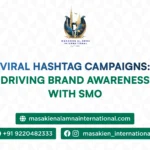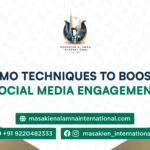
How to Use LinkedIn for Lead Generation in B2B Marketing
In this digital era, LinkedIn is an emphatic hammer in the B2B marketing utility catcher, a real treasure chest for companies aiming to approach professionals, decision-makers, and industry influencers. Unlike other social media platforms, LinkedIn is created for business-level discussions, networking, and lead nurturing. B2B marketers highly appreciate this platform for its precise targeting abilities, its rich data of true professionals, and its direct line to decision-makers.
Yet knowing about LinkedIn would not help a single penny without having a set lead generation plan to be implemented strategically. This blog discusses the best techniques and approaches for leveraging LinkedIn for quality B2B lead generation.
1. Optimization of Company Page and Personal Profiles
A. Set Up Company’s Page
The establishment of an attractive company page for your company is the very first step to attract interest from would-be leads. It should own an unambiguous description of your business, a professional logo, and an eye-catching banner image. Tell them about your services, your achievements, and what separates you from your other industry colleagues.
B. Personal Profiles Should, at Times, Connote Credibility
In a B2B arrangement, these people relate to people, not just brands. If your LinkedIn program includes sales teams or marketing teams, their profiles must be well-made and complete. Include their professional photo, keyword-filled headlines, and experience summaries that go straight to their audience.
Such a profile creates instant credibility. The contact info must be current, and the About section must list who you stand for and how. Credibility can be enhanced by the presence of client testimonials, endorsements, and featured posts.
2. Define Your Target Audience
A. Using Advanced Search Filters
With the LinkedIn Search, you can delve deeper into focusing on your perfect prospect. Filter by industry, company size, job title, location, etc.—all these give you an easy way to make an outreach list that is focused on your buyer persona.
This further divides into segments, so you do not send messages that are generic but actually apply solutions that are personalized. Then it’s just that LinkedIn Premium or Sales Navigator offers even deeper filters, such as years of experience, job changed recently, or company growth signals.
B. Develop a Detailed Buyer Persona
Before beginning any outreach, it is important to determine who the ideal client is. Go beyond simple demographics and look into pains or challenges, job responsibilities, and what triggers their decision-making process. The more thorough the persona, the more likely it is that your messaging will be appropriate to them.
For instance, rather than merely going after “marketing managers,” target “B2B marketing managers in SaaS companies with 50-200 employees that are in need of increasing the lead flow.” Being specific will assure that the lead you’re attracting has a higher chance of conversion.
3. Publish and Share Useful Content
-
A. Educate. Don’t Sell.
People don’t want to get sold to—they want to be helped. When you share thought leadership content like how-tos, industry trends, and case studies, you begin to position your brand as an authority willing to help rather than just selling.
Educating the market nurtures trust and awareness, and when the buyer is ready to make a decision, they will most likely choose you because of the pre-sale value you provided. Check out our latest blog post on The Best Social Media Platforms for B2B vs. B2C Marketing in 2025
B. Have the Content Format Varied
Depending on the individuality, there can be many content types. Make your content appealing with varying text posts, carousel posts, infographics, videos, and LinkedIn articles. This variety keeps a business’s content lively and interesting while accommodating at least a few learning styles.
Videos that explain solutions or share customer testimonials are very effective in B2b environments. Articles and newsletters, meanwhile, build your expertise while giving followers a reason to engage and interact with you regularly.
4. Use LinkedIn Lead Gen Forms
A. Sponsored Content with Lead Forms
Lead Gen Forms of LinkedIn act as a powerful nipple of its ad platform. When anyone clicks your ad, the form gets auto-filled with their profile data, removing the need to fill the form manually, thereby increasing the conversion rates.
Try using lead forms with offers of value, such as delivering an e-book, free trials, consultations, or webinars. Meaningful content that is able to address the major challenge of your potential market should be the content you promote.
B. Keep It Simple and Make the Offer Too Tempting to Refuse
Don’t crank up the form with extraneous fields. Ask just for the essentials—names, email addresses, job titles, and, sometimes, companies. With such simplicity, make your offer compelling.
Do not put unnecessary fields on your form. Request only what is necessary. Name, email, job title, and company are usually sufficient. This will make signing up much easier when combined with a great offer.
Follow up promptly with a thank-you message or email and by delivering the promised asset. This keeps your brand on the recipient’s mind and opens the door for them to become engaged further.
5. Engage Through Comments and Conversations
A. Be Active in Relevant Groups
The groups on LinkedIn are niche communities where professionals gather to discuss various issues related to the industry. Join groups that are pertinent to your field and provide input, not to sell but rather to share knowledge and be helpful.
This sets you apart as a thought leader within the industry and places you first in the minds of those who are potential leads through organic attraction. Make sure to respect group rules and provide pure value.
B. Start conversations in comments
Commenting with insight on relevant posts is an artful yet subtle way to garner leads. By engaging in discussions in the posts of your target audience, you express interest, prove knowledgeability, and start building goodwill.
Such interactions often translate into profile visits, connection requests, and deeper conversations. Just be sure to comment with something insightful, not just a generic “great post.”
6. Use LinkedIn Messaging for Personalized Outreach
A. Avoid Spammy Sales Pitches
Please don’t just jump into somebody’s inbox with a hard sell. Instead, send them a message stating who you are and how you can help them. Point to something about their profile or their company that means you have done your homework.
So naturally, build the idea of a conversation going forward, either from something that interests you both or a group you belong to, and then discuss how your service can meet that need.
B. Use a connection-first app
This will cement your position as a thought leader in the industry and enable you to attract potential leads into your space naturally. Remember to obey group rules and contribute genuinely.
Over time, the relationship gets nurtured by small touches: commenting on their posts, liking their updates, and only when interest is in plain sight, suggesting to meet or to have a call. Patience and persistence are treated as virtues in B2B selling.
7. Run LinkedIn Ads to Target Precisely
A. Choose the Ad Type
LinkedIn offers a variety of ad types: sponsored posts, message ads, video ads, carousel ads, and more. Choose according to your target: awareness, engagement, or lead generation.
For lead generation, sponsored content with lead-generation forms usually proves most effective. They are retargeting interested users with short video ads or spotlight ads to keep the brand top of mind.
B. Retarget and Matched Audiences
Retarget people who’ve visited your website or interacted with your past ads; these users are warmer leads and thus more likely to convert. Use LinkedIn’s insight tag on your website to build these audiences.
Upload your customer list or CRM data to create matched audiences, which can then be targeted through campaigns and searches for these lookalikes or existing leads. This will substantially maximize your conversions.
8. Measuring, Analyzing, and Refining Your Strategy
A. Monitor Key Metrics
Always monitor important metrics such as engagement rates, click-through rates (CTR), conversion rates, and cost per lead. These metrics provide insight into what is working and what must be adjusted.
Organic strategies should account for the views of profiles, the growth of followers, and interactions with the content. In the case of ads, lead quality is measured by return on investment. Always compare the recorded results with your objectives, and adjust the performance correspondingly.
B. A/B Test Your Messaging and Content
Never assume anything; throw at the audience various versions of your headline, CTA, image, and ad copy—that will tell you what truly resonates. This process then allows you to further refine your messaging and base your next steps on data.
Today is not tomorrow. So be agile and ready to pivot as results direct you. Continuous improvement is opening many doors for LinkedIn in B2B lead generation.
Conclusion: B2B Lead Generation Power of LinkedIn
When used strategically, LinkedIn is more than a networking website—it is a lead generator. With the correct optimization of one’s presence, targeting the correct audience, providing value with content, and real engagement, relationships do form with leads and clients.
Giving value, building trust, and being consistent—this is the underbelly. Be it a startup or a huge organization, contact us as LinkedIn can fill that sales pipeline with the right kind of B2B prospects—you just have to use it properly.





1 Comment
How to setup a youtube channel for business in 2025 - Masakienalamnainternational
July 30, 2025
[…] Before starting video uploading, work out a content strategy representative of your marketing objectives and target audience. Find what your audience wants to see (tutorials, product demos, FAQs, behind-the-scenes, customer testimonials). Check out our latest blog post on How to Use LinkedIn for Lead Generation in B2B Marketing […]